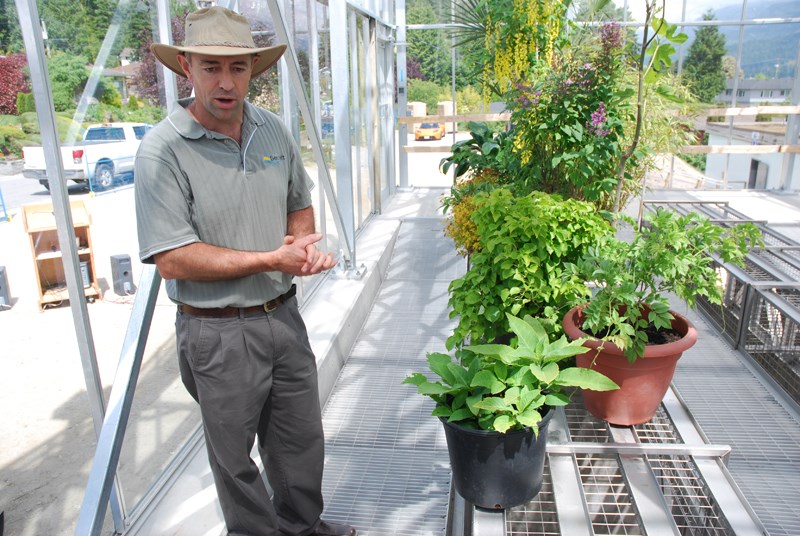Following the announcement of the new name for Sechelt’s sewage treatment plant last week (Sechelt Water Resource Centre), guests were invited to tour the facility and learn more.
Project coordinator Paul Nash explained that the sewage coming into the new plant will be treated to a higher standard than most with the use of ultra-violet disinfection, special membrane filtration and the Organica process.
Organica is the growing of plants in treated wastewater. The plants are positioned in baskets above a tank of wastewater and the plant roots are suspended in the liquid. The roots provide more surface area for the bacteria used in the breaking down of wastewater to grow and thrive.
On the Coast the plants will be housed in a greenhouse to keep them alive all year, but Nash wasn’t sure exactly what kinds of plants would be used.
“Organica has tried out about 300 different species of plants to date, and they’ve found about 100 that work well and that’s what will be put in here,” Nash said. “So I haven’t actually got the plant list, that’s their top-secret information because it’s taken them years to develop that, but all the plants that they need, they can buy locally.
“Not all of the plants that they’ll put in here are native, but they’re all ones that you can walk down to a garden centre and buy.”
He explained the plants chosen had to be able to handle having their roots submerged in water all the time.
“So you can imagine it favours sort of fleshy tropical-like plants, reeds and marshes and things like that, but there is quite a variety,” Nash said. “Then we will experiment by getting some B.C. native plants that they haven’t tried yet and we can play around in here and see what local plants grow.”
In an effort to find a plant species that could perhaps be profitable, Nash investigated the growing of marijuana in the greenhouse at one point, but said it would be difficult, if not impossible, to sell a product you smoke that was grown in sewage.
What’s left at the end of the treatment process is water that will be chlorinated and available for irrigation uses and a sludge that will be dewatered and trucked to Salish Soils for compost, Nash said.
Salish Soils CEO Aaron Joe said the sludge will be composted separately from the fish and curbside organic composting that’s now going on.
Some have been concerned about pharmaceutical products making it through the sewage treatment process and into the compost, and Nash addressed that issue during the May 21 tour.
“Pharmaceuticals are biological products. Some of them are degraded, in that some of them end up leaving here with the sludge and some of them that are highly water-soluble remain in the water. So most of them get degraded to some extent but not all of them,” Nash said. “Even some harmless things like caffeine can make it through the process. You end up with about 25 per cent of the caffeine on the way out that came in. So some are degraded, some end up in the biosolids, and they are further degraded in the composting process. And then when it’s put out into the soil, some of those are further degraded in the soil.
“There are some experimental post-treatment technologies out there for doing specific removal of the hormones and pharmaceuticals, but right now there’s no off-the-shelf treatment that we can add. But we are looking at that as a future thing, as an add on to the reuse.”
He said there wasn’t much reason for concern because “if it’s OK for you to take it as a pill, if one millionth of it ends up in the food, it’s probably OK.”
“The problem with some of them is they can bio-accumulate in the food chain. They call them endocrine disruptors and they cause problems with frogs and things like that,” Nash said.
“You can imagine some places in the States where you’ve got horrible water and they use a lot of drugs and stuff down there.
That’s caused real problems. Here, we don’t think we’re at that level, but that’s an area of future investigation for us.”
You can find out more about the new Sechelt Water Resource Centre during the next tour set for Friday, June 13, at 1 p.m.
To sign up for a tour, contact the District of Sechelt at [email protected] or call 604-885-1986. Special tours can also be arranged.



